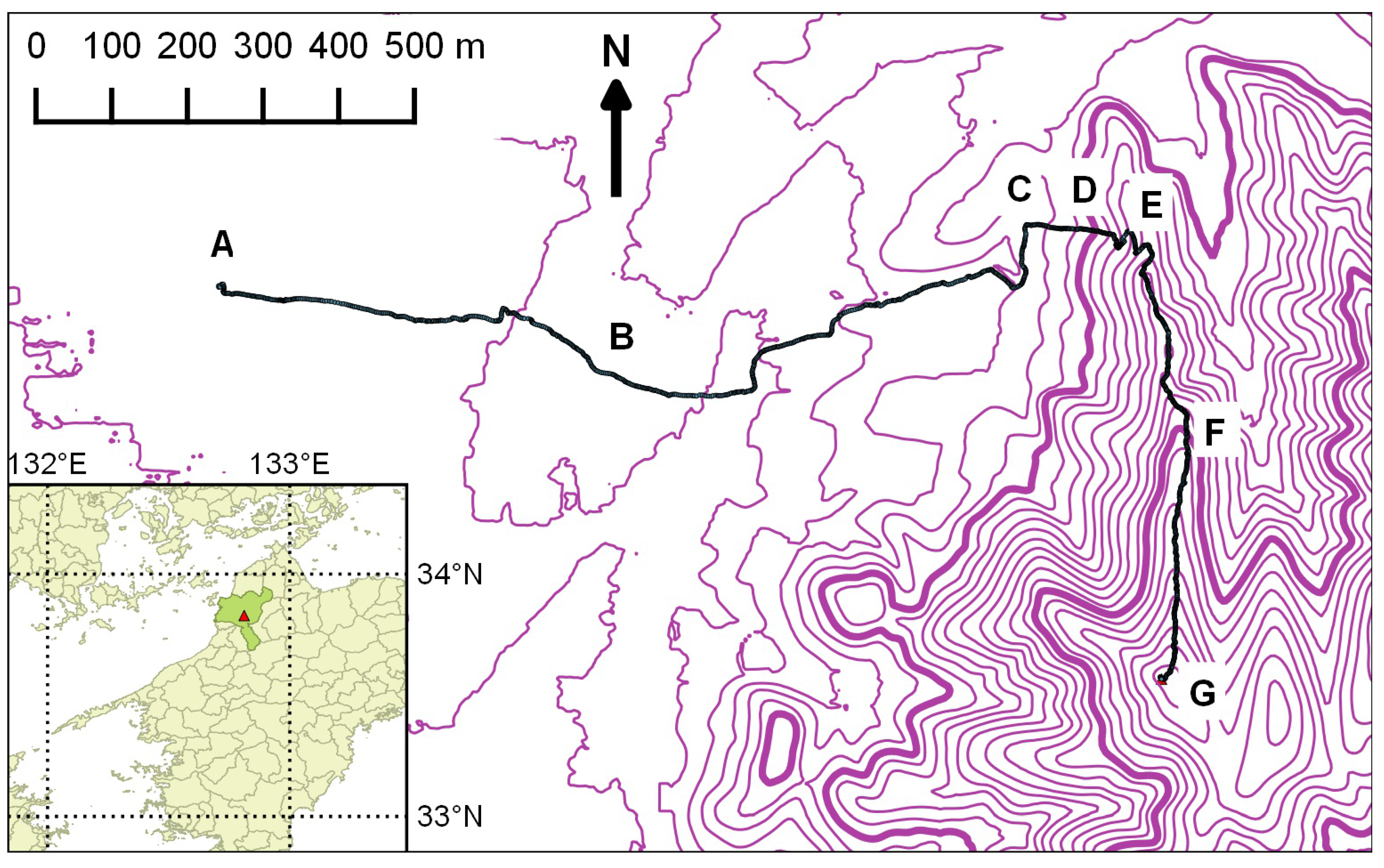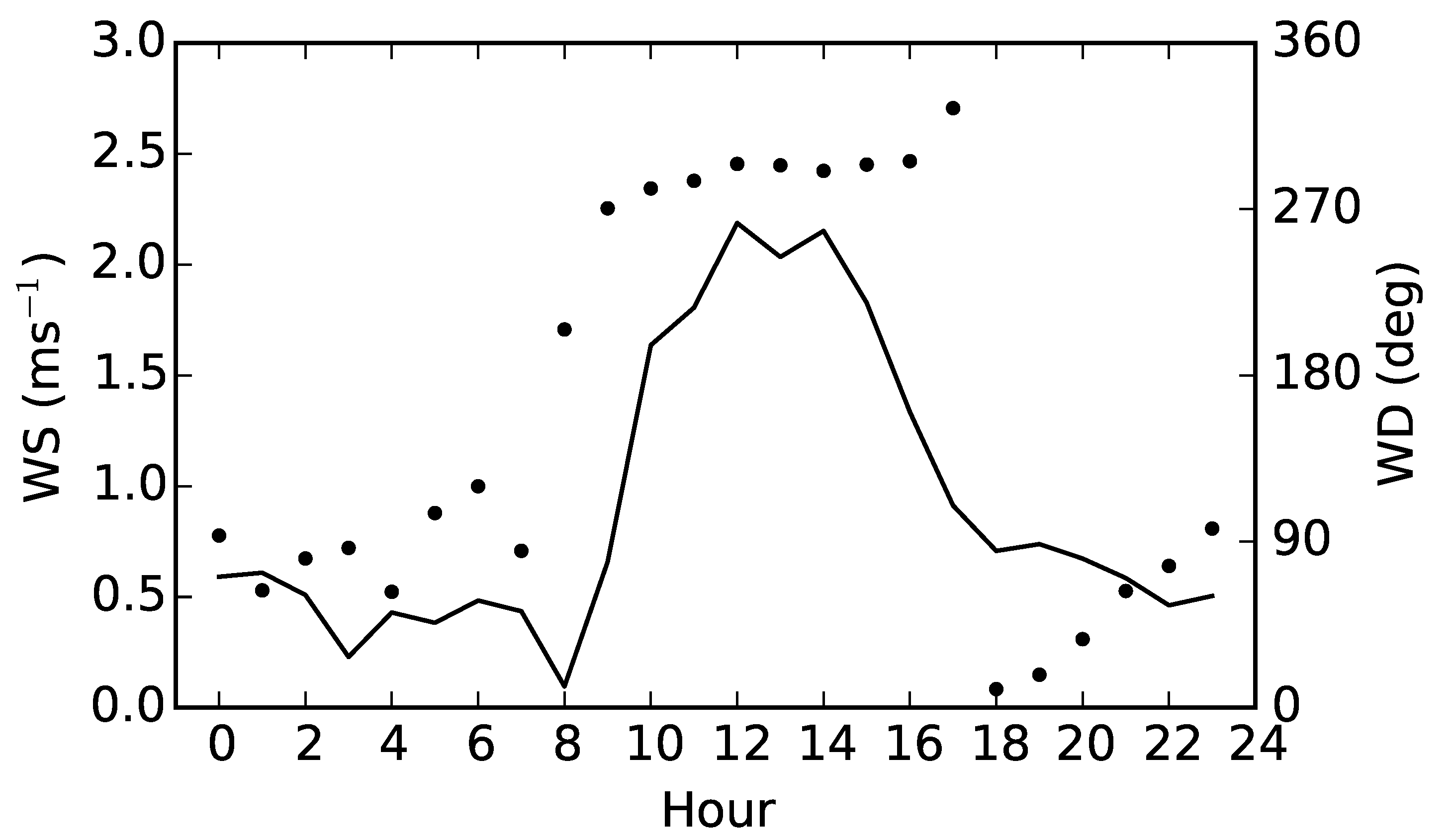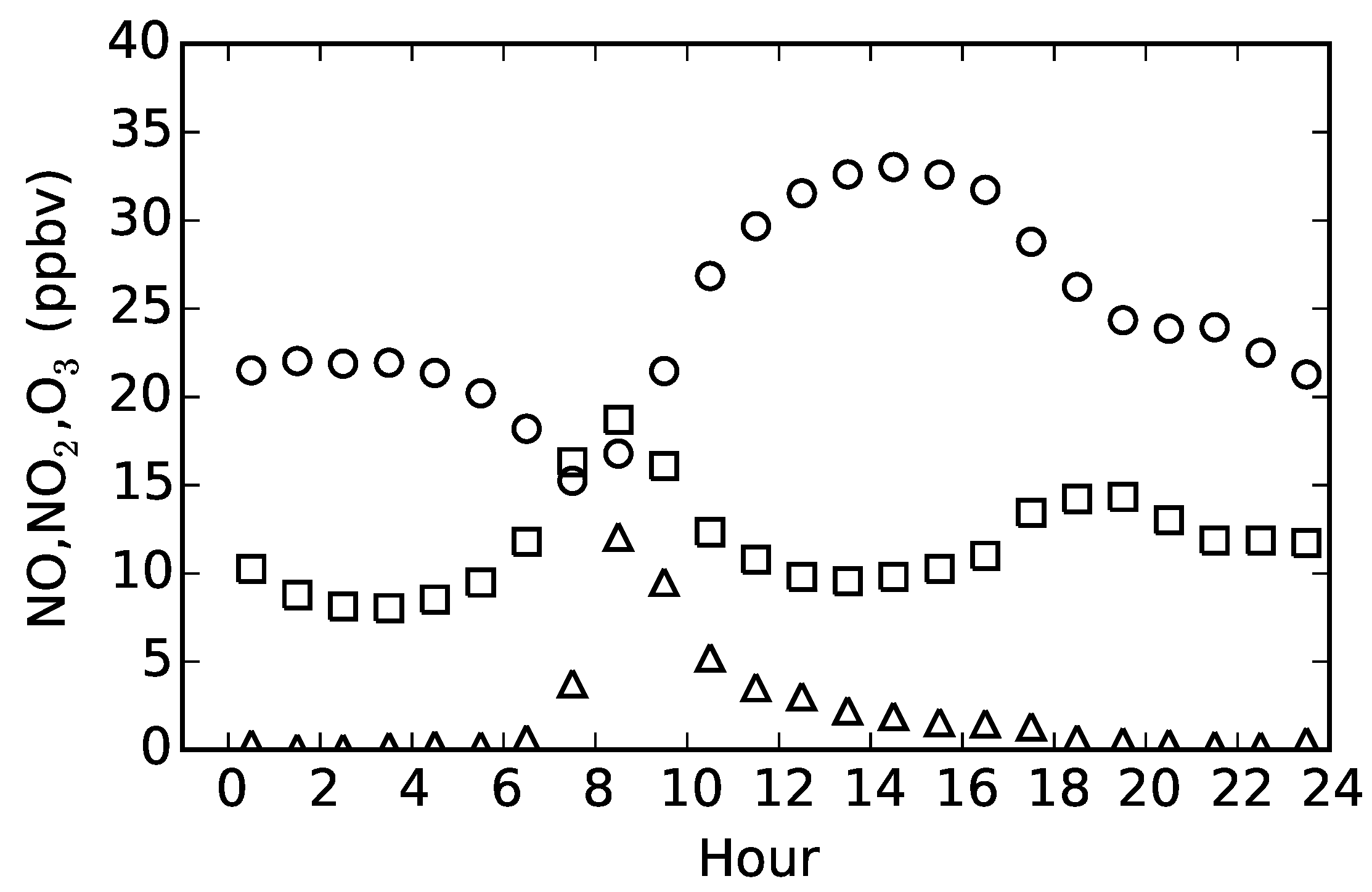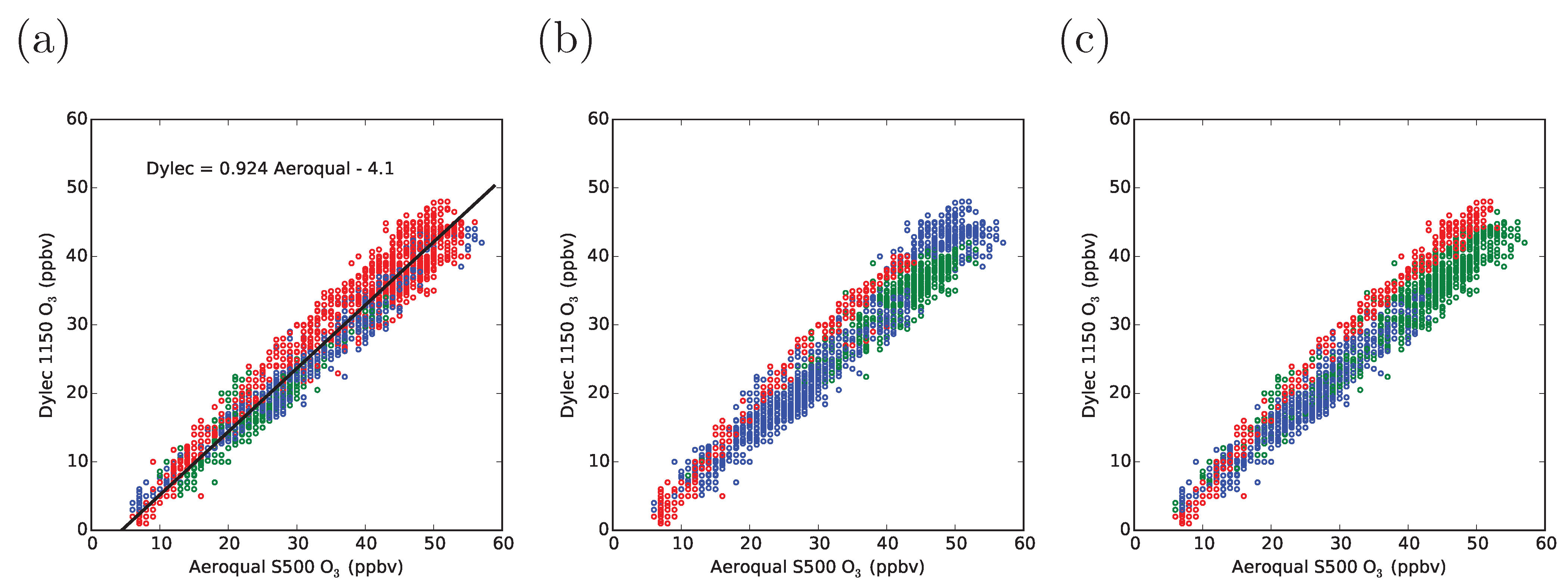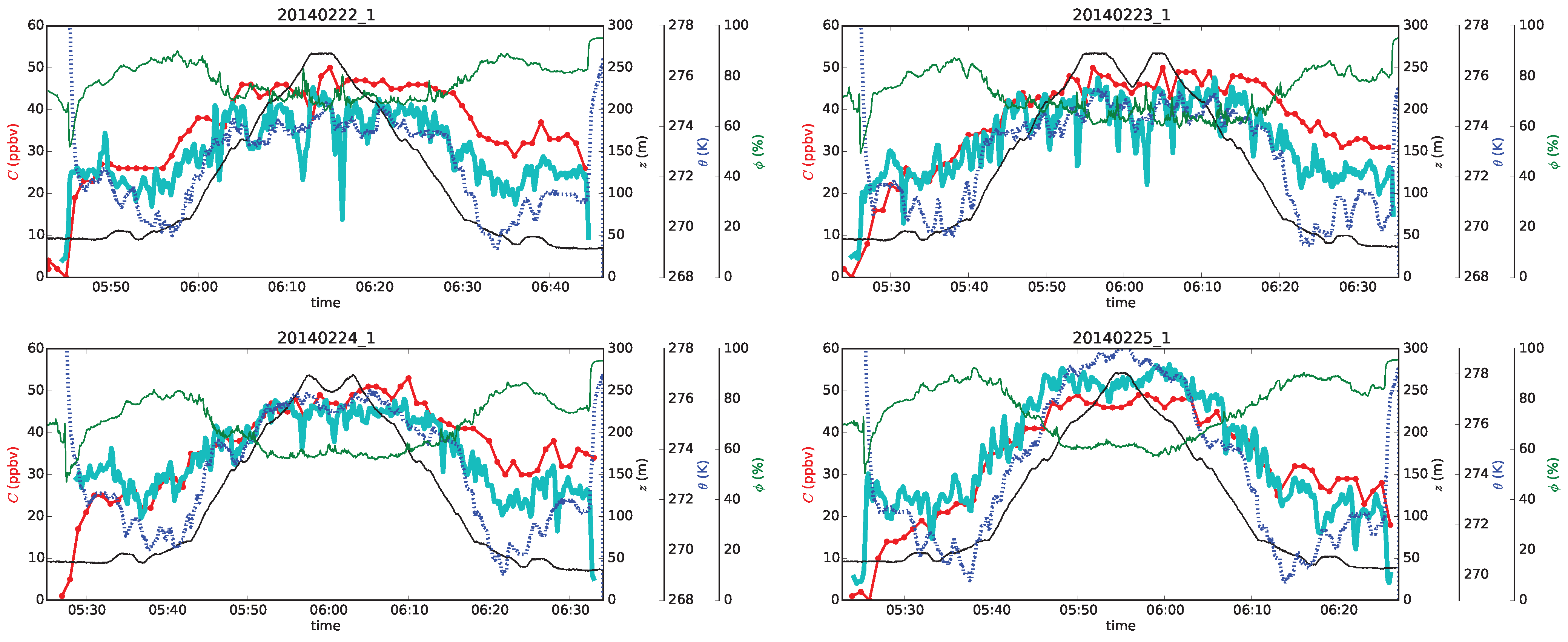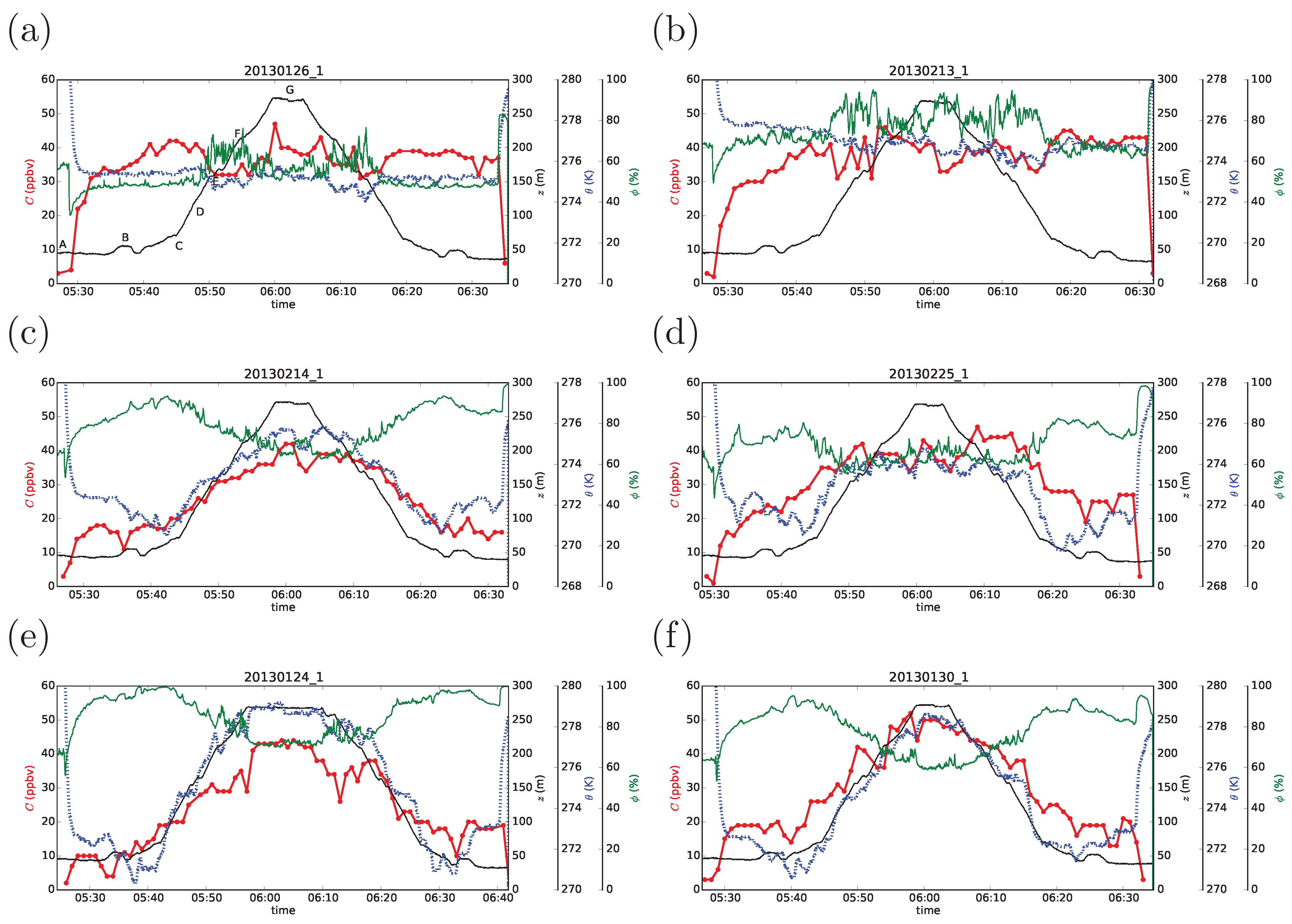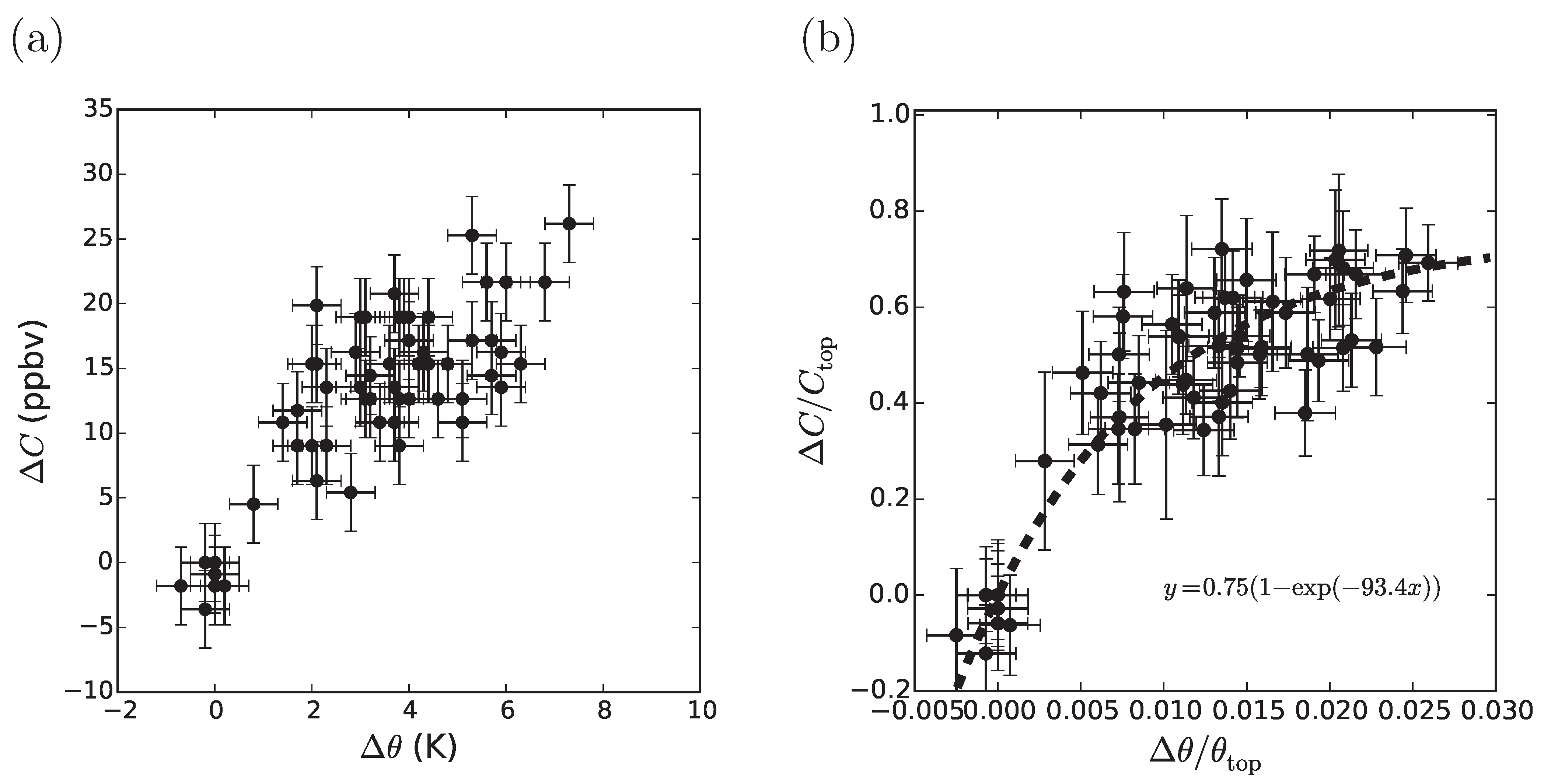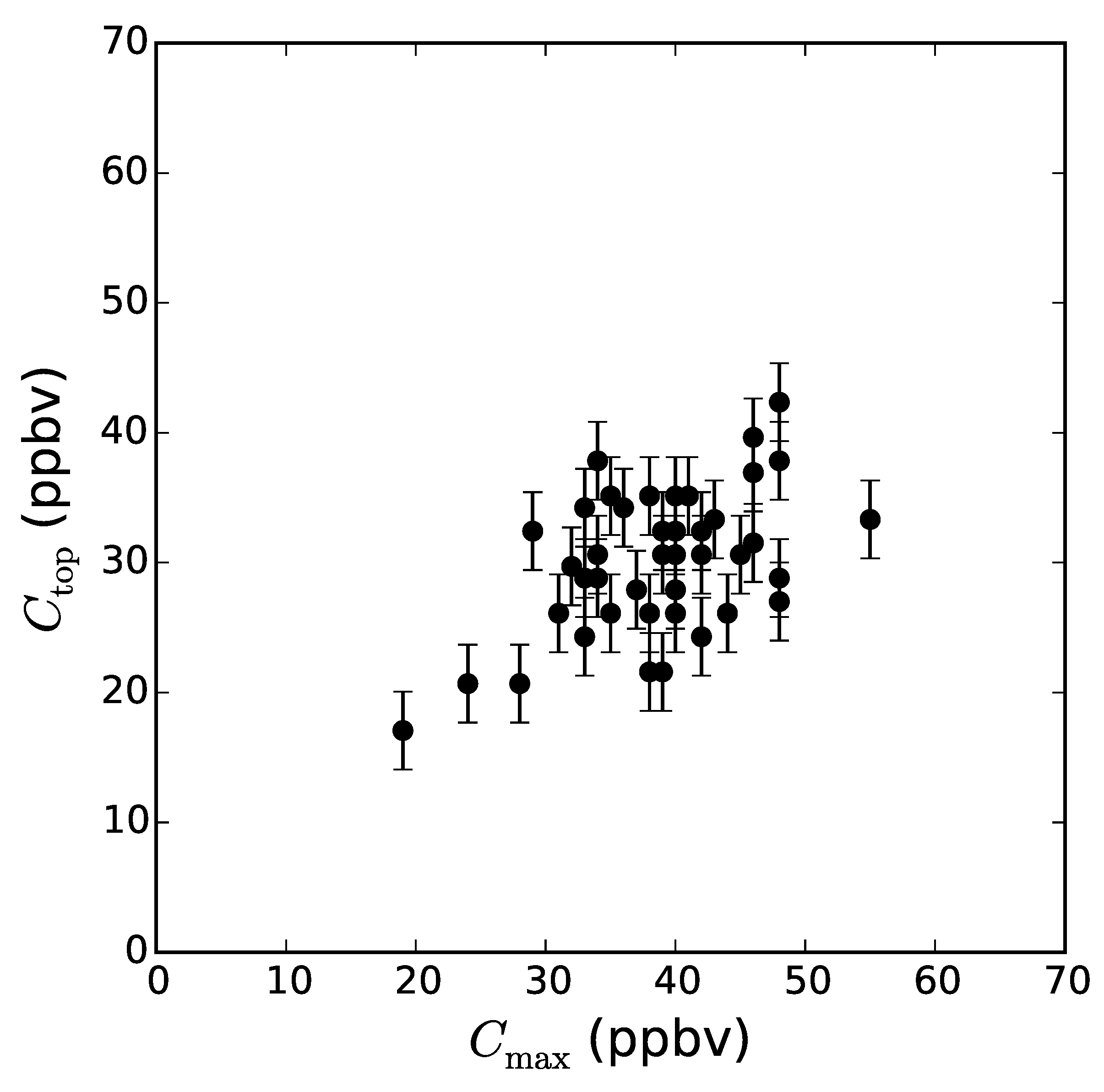3.1. Properties of the Aeroqual S500
An important property of the Aeroqual S500 is the dependence on ambient conditions, such as temperature (
T), relative humidity (
ϕ) and atmospheric pressure (
P). Gundel
et al. [
22] compared the performance of various ozone analyzers based on different principles, such as UV absorption, electrochemical concentration cell and heated metal oxide (Aeroqual S500). They used a stainless chamber to which output of an ozone generator was connected and in which the air condition was controlled arbitrarily. Assuming that an ozone analyzer based on UV absorption (API Model 400, Teledyne Technologies Inc., Thousand Oaks, CA, USA) gave the true concentration, the readings of the other devices were normalized by that of API Model 400. The dependence on
P varied among different test runs, but approximately, the reading of the Aeroqual S500 became 10% smaller per pressure drop of 25 hPa. The dependence on
ϕ was relatively repeatable, and the reading of the Aeroqual S500 increased by 50% per a drop of relative humidity of 40%. The dependence on
T varied considerably among test runs, and there were signs of a hysteresis behavior; however, overall, the reading of the Aeroqual S500 decreased by 25% per temperature increase of 5 °C. The above-mentioned changes of
P,
ϕ and
T are typical magnitudes experienced while climbing Awajigatou on a day with strong surface inversion. Therefore, the change in the atmospheric condition over the height of Awajigatou was expected to have competing effects of similar magnitudes on the Aeroqual S500.
In practice, it is necessary to compare the Aeroqual S500 that was actually used for observation with a UV-based ozone analyzer in the real atmosphere.
Figure 4 shows the result of such a comparison conducted on an open-air walking bridge between school buildings of the department of agriculture of Ehime University. The reference ozone analyzer was the Dylec 1150 (Dylec Co., Ltd., Ami, Japan), which had been confirmed to agree with a similar UV-based ozone analyzer used for continuous measurement at permanent air-monitoring stations in Ehime prefecture, Japan. Comparison measurements were conducted on 31 days between 7 January and 23 February 2013, each lasting for about an hour around 9:00, 12:00, 14:00 or 16:00, except for a case that continued for 24 h. The ambient
T,
ϕ and vapor density (
) ranged from −1.3 to 19.8 °C, from 20% to 90% and from 2.6 to 10.5 g·m
−3, respectively. Each point in
Figure 4 represents a datum of the Aeroqual S500 at its sampling time (every 60 s) and that of the Dylec 1150 at its sampling time (every 12 s) closest to that of the Aeroqual S500. The marker color in
Figure 4 indicates the levels of
T,
ϕ or
.
Table 1 lists the least-squares regressions for each level of
T,
ϕ or
. Although there was a weak tendency that the reading of the Aeroqual S500 became lower as
T increased or
ϕ increased, linear regression resulted in rather irregular variations in the slope and
y-intercept for different ranges of
T or
ϕ. Furthermore, the change of the reading due to changes in
T or
ϕ was comparable to the variation in the reading of the Aeroqual S500 for repeated measurement at a fixed point for several minutes. The cause of variability has not yet been clarified, but probable causes are fluctuations in sensor temperature and ambient wind condition. It was therefore decided that the difference in the linear regression for different
T or
ϕ ranges was not significant, and a calibration relation was determined using the whole measurement data.
Figure 4.
Correlations between the Aeroqual S500 and the Dylec 1150 for the measurement of ambient ozone concentration. Panels (a–c) show the same data with different colors depending on T (°C), ϕ (%) and (g m−3), respectively. The color definitions are: (a) (green), (blue), (red); (b) (green), (blue), (red); and (c) (green), (blue), (red).
Figure 4.
Correlations between the Aeroqual S500 and the Dylec 1150 for the measurement of ambient ozone concentration. Panels (a–c) show the same data with different colors depending on T (°C), ϕ (%) and (g m−3), respectively. The color definitions are: (a) (green), (blue), (red); (b) (green), (blue), (red); and (c) (green), (blue), (red).
Table 1.
Least-squares regression between the Aeroqual S500 and the Dylec 1150 for different levels of T, ϕ or . R indicates Pearson’s correlation coefficient.
Table 1.
Least-squares regression between the Aeroqual S500 and the Dylec 1150 for different levels of T, ϕ or . R indicates Pearson’s correlation coefficient.
| Item | Range | Least-Squares Regression | R |
|---|
| T (°C) | | | 0.93 |
| | 0.99 |
| | 0.98 |
| ϕ (%) | | | 0.92 |
| | 0.98 |
| | 0.99 |
| (g m−3) | | | 0.98 |
| | 0.97 |
| | 0.99 |
With Pearson’s correlation coefficient of 0.98, the linear-regression relation between the Dylec 1150 and the Aeroqual S500 became:
It should be noted that similar comparison runs conducted in summer 2013 (
–35.2 °C,
%–74%,
–22.4 g·m
−3) resulted in a much lower reading of the Aeroqual S500 ((Dylec 1150) ≈ 1.35 × (Aeroqual S500)). Therefore, the Equation (
1) is valid only during the winter observation period.
To further confirm that the measurement by Aeroqual S500 was not strongly affected by variations in
T,
P or
ϕ along the mountain, an on-site comparison was conducted using a lightweight battery-operated UV-based ozone analyzer (Model 202, 2B Technologies, Boulder, CO, USA) that was acquired much later than the main measurement campaign. The nominal precision and response time of the 2B Model 202 are 1.5 ppbv (or 2% of reading) and 20 s, respectively. Both the Aeroqual S500 and the 2B Model 202 were carried up Awajigatou on 22, 23, 24 and 25 February 2014 (note the different year from the observations reported in much of this article).
Figure 5 shows the result. In
Figure 5, the data of the Aeroqual S500 were converted by Equation (
1) to be equivalent to the Dylec 1150. The 2B Model 202 was confirmed to agree with the Dylec 1150. The difference between the Aeroqual S500 and the 2B Model 202 varied from day to day, but no consistent dependence on
T,
P or
ϕ was found. The difference between the Aeroqual S500 and the 2B Model 202 was comparable to the uncertainty found for the comparison between the Aeroqual S500 and the Dylec 1150. The four measurements in
Figure 5 are not used in the following analysis.
Figure 5.
Comparison between the Aeroqual S500 (red) and the 2B Model 202 (thick cyan) for four Awajigatou measurements. Explanations of other quantities are given in
Figure 6.
Figure 5.
Comparison between the Aeroqual S500 (red) and the 2B Model 202 (thick cyan) for four Awajigatou measurements. Explanations of other quantities are given in
Figure 6.
3.2. Hill Measurement Results
Representative behaviors of the potential temperature (
θ), relative humidity (
ϕ), elevation (
z) and ozone concentration (
C) are shown in
Figure 6. The ozone concentration data
C of the Aeroqual S500 are the result of conversion using Equation (
1). The elevation
z was calculated from the atmospheric pressure assuming a hydrostatic state of a column of air with a mean density between the foot and the top of Awajigatou. Along the measurement route,
θ,
ϕ and
C changed gradually with
z, but abrupt changes often occurred at canopy edges or changes of the elevation gradient. However, because such changes were not always reproducible in a few immediately-conducted repeated climbs and because the short timescale of such changes was not suited to the low time resolution of the Aeroqual S500, we focus on the difference between the bottom and top of Awajigatou in the following analysis. The short-scale variations as shown in
Figure 5 for the measurement results by the 2B Model 202 were considered to be caused by uphill flows along valleys. A detailed analysis with wind-field measurements will be reported in a forthcoming paper.
In the case of
Figure 6a,b, the weather was cloudy and windy, and the profile of
θ was flat, representing a neutral atmospheric condition. In this case,
C was also generally uniform, because of the well-mixed state of a neutral boundary layer. In the case of
Figure 6c–f, the weather was fine with weak wind, and
θ increased with
z, typical of stable atmospheric condition. The surface layer was more stable (the temperature difference between the top and the bottom was larger) in
Figure 6e,f than in
Figure 6c,d. In these cases,
C also increased with
z. As described later, the top-bottom difference of
C was larger for a larger top-bottom temperature difference.
Figure 6.
Representative results of Awajigatou measurements: ozone concentration C (red), elevation a.s.l. (black), potential temperature θ (blue) and relative humidity ϕ (green). Thermal stratification were neutral in (a,b), moderately stable in (c,d) and strongly stable in (e,f).
Figure 6.
Representative results of Awajigatou measurements: ozone concentration C (red), elevation a.s.l. (black), potential temperature θ (blue) and relative humidity ϕ (green). Thermal stratification were neutral in (a,b), moderately stable in (c,d) and strongly stable in (e,f).
A neutral condition as in
Figure 6a,b was rather rare; in only 16 out of 66 observations was
found to be less than 2 K (corresponding to an overall Richardson number of 1.0 for a relatively large wind speed difference of 4
between the top and bottom of Awajigatou), where:
and
and
are the values of
θ at the top and bottom of Awajigatou, respectively.
It should be noted that the count of Class D (neutral) in terms of the Pasquill–Gifford (PG) stability classification (see [
23] for the definition adopted here) based on the measurement data of wind and cloud coverage at 6:00 at the Matsuyama meteorological observatory located in the center of the Dogo plain (
Figure 1) was 36, more than twice as large as the count of cases with
.
Figure 7 shows the relation between
observed at Awajigatou and the PG classes. We observe a tendency that
increases for more stable PG classes (D→E→F→G), but the variation of
in each class is so large that it is impractical to predict
from the measurement at the Matsuyama observatory, or
vice versa.
Figure 7.
Correlation between the potential temperature difference between the bottom and top of Awajigatou and the Pasquill-Gifford stability class determined by the wind and cloud coverage observed at Matsuyama meteorological observatory at 6:00 on the same day as the corresponding Awajigatou measurement.
Figure 7.
Correlation between the potential temperature difference between the bottom and top of Awajigatou and the Pasquill-Gifford stability class determined by the wind and cloud coverage observed at Matsuyama meteorological observatory at 6:00 on the same day as the corresponding Awajigatou measurement.
The relationship between the vertical differences in
θ and
C is analyzed. Similarly to
,
is defined as:
where
is the value of
C at the foot of Awajigatou (around C in
Figure 1). Because the response of the Aeroqual S500 is faster when
C decreases than when
C increases,
was evaluated on the return route from the summit. The values of
and
were determined rather subjectively by eye based on plots like
Figure 6, excluding irregularities due to air-inlet obstruction or occasional measurement failures.
Figure 8a shows the relation between
and
. Pearson’s correlation coefficient between
and
was 0.83, which was found significant by Student’s
t-test at the 1% significance level. This behavior agrees qualitatively with those obtained by previous authors [
12,
15].
In
Figure 8b, the differences are normalized by the respective values at the top of Awajigatou. Assuming that
when
and that
tends to a finite value of 0.75 (determined rather subjectively by visual inspection of
Figure 8b), the following relation was obtained by the least-squares method,
Pearson’s correlation coefficient between and was 0.77, which was found significant by Student’s t-test at the 1% significance level.
Figure 8.
Correlations between the temperature difference
and the ozone concentration difference
at the bottom and top of Awajigatou in dimensional (
a) and non-dimensional (
b) forms. The dashed curve in panel (b) indicates Equation (
4).
Figure 8.
Correlations between the temperature difference
and the ozone concentration difference
at the bottom and top of Awajigatou in dimensional (
a) and non-dimensional (
b) forms. The dashed curve in panel (b) indicates Equation (
4).
This relation can be used to predict
from
, which can be obtained at a much lower cost and effort than
. The Equation (
4) is specific to Awajigatou in winter, but similar relations at different sites in different seasons can be obtained by conducting similar measurements. Although not reported here in detail because of the small number of observation data, summer-time experiments resulted in considerably different coefficients in Equations (
1) and (
4).
Under stable atmospheric conditions,
, the value of
C at the top of Awajigatou, represents the ozone concentration in the residual layer. As mentioned in
Section 2.1, the pre-dawn residual layer contains ozone produced near the ground and brought up by convection during the previous day. The air mass in the residual layer may have been transported from outside the Dogo plain, but the surface-level ozone concentrations were generally well correlated in the surrounding regions. Therefore,
is expected to be correlated with the daily maximum concentration
of ozone on the previous day in the Dogo plain. Because the top of Awajigatou was not a location of occasional sudden signal drops, as shown in
Figure 5,
is a robust measure of ozone concentration at the summit elevation. It should be noted that this kind of data qualification was only possible by our spatially-continuous measurement.
Figure 9 shows the scatter plot of
and the daily maximum ozone concentration
on the previous day at the Tomihisacho ambient air-monitoring station. Pearson’s correlation coefficient between
and
was 0.52, which was found significant by Student’s
t-test at the 1% significance level. Generally,
was larger than
, consistent with no photochemical production, but continued mechanical and chemical destruction at night.
Figure 9.
Correlation between the ozone concentration measured at the top of Awajigatou and the daily maximum ozone concentration observed at the Tomihisacho ambient air monitoring station on the previous day of the corresponding Awajigatou measurement.
Figure 9.
Correlation between the ozone concentration measured at the top of Awajigatou and the daily maximum ozone concentration observed at the Tomihisacho ambient air monitoring station on the previous day of the corresponding Awajigatou measurement.
